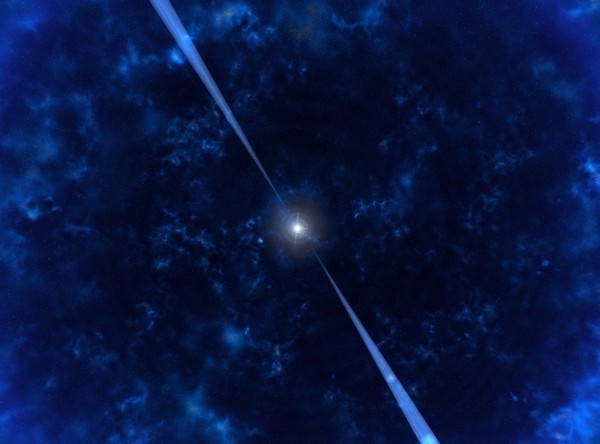Update: 09/09/2009

The millisecond pulsars are known to be neutron stars, remnants of the explosion of a big star, with an original mass ten times that of the Sun. Combined with their rapid spin (up to 800 rotations in a second), their strong magnetic field (~ 108 – 109 Gauss) accelerates charged particles from the star surface, or from some outer gaps in the high magnetosphere, and produces two beams of light sweeping space like the lens of a light-house. The geometry of this emission is complex and its mechanism not well known yet. A few month ago, it was not sure at all that we could detect millisecond pulsars thanks to their gamma-ray emissions because the energy available to trigger and feed a high energy emission was estimated to be below a certain threshold projected from models.
The Large Area Telescope on board of the FERMI satellite is now scanning the gamma-ray sky since August 2008, after a successful launch on June 11th. In a few month only, thanks to its higher sensitivity, height millisecond pulsars were discovered and millisecond pulsars were defined as a new class of high energy sources. An international team leaded by investigators of the Centre for the Study of Radiation in Space (CESR) of Toulouse (INSU-CNRS, University of Paul Sabatier) used the same telescope to show for the first time the gamma emissions of the globular cluster 47 Tucanae. Only 23 millisecond pulsars had been observed in the radio and X-ray range in this cluster. By comparing the globular cluster's gamma emissions with the millisecond puslars' observed by FERMI, the CESR's investigators could deduced that 47 Tucanae was hosting 60 millisecond pulsars.

The globular clusters are dense and spherical systems composed of old stars formed 10 billion years ago in the halos of the galaxies.
Those clusters should have collapsed for a very long time if, by gravitational interaction, the stars were not linked in double or even triple systems. The millisecond pulsars' existence directly results from this star ballet, and by observing them we have the great opportunity to study the cluster's stability and dynamic evolution.
FERMI partnerships and the involvement of the French teams

The FERMI collaboration involves NASA and DOE on the American side with institutes of six countries (United-States, France, Italy, Japan, Sweden and Germany).
On the French side, five teams of the IN2P3/CNRS (LLR, CENBG, LPTA), CEA (IRFU/SAp) and INSU/CNRS (CESR) are involved.
The calorimeter's structure, built at LLR, is the technical contribution to the instrument. The detector's response to different types of particles was studied in detail by the IN2P3's teams using computer simulations and several tests with particle accelerators, particularly at CERN research centre. Sophisticated analysis and calibration techniques were developed by those teams and will be undertaken during the flight. The group CEA/SAp is responsible for establishing the source catalogue with the CESR helping to identify them.
FERMI instruments
The Large Area Telescope (LAT)
- Because the sky at gamma-ray energies has so many variable sources, the LAT must have a large field of view, over 2 steradians (one-fifth of the entire sky).
- To identify and study sources accurately, the LAT must be able to measure the locations of bright sources to within 1 arcminute (about 1/30 of the diameter of the full Moon).
- The study of gamma rays covers a broad energy range, so the LAT must catch photons with energies from 30 MeV to greater than 300 GeV. In particular, the LAT will have high sensitivity above 10 GeV, because almost nothing is known about cosmic objects at these energies.
- Since gamma-ray bursts can release a torrent of gamma rays within a fraction of a second, the LAT must be able to measure gamma rays over short time intervals.
- Because scientists need long observations to understand many types of sources, the LAT should be able to operate for many years without degradation.
- Because of the high flux of cosmic rays, which can mask the much smaller flux of gamma rays, the LAT must be able to reject 99.999% of signals generated by cosmic rays.
The GLAST Burst Monitor (GBM)
- Gamma-ray bursts (GRBs) come from random directions of the sky, so the GBM must watch as much of the entire sky as possible at all times.
- To gain the most information about GRBs, the GBM should be able to measure photon energies over a wide range, down to 8 keV and up to energies that overlap the LAT energy range.
- Since GRBs last from mere microseconds to thousands of seconds, the GBM must be able to detect GRBs over a wide range of timescales
Article references
Detection of High-Energy Gamma-Ray Emission from the Globular Cluster 47 Tucanae with Fermi. Abdo, A.A., et al., Science 325, 845 (2009)
Contacts
- Scientific contacts: Jürgen Knödlseder, Centre d’Etude Spatiale des Rayonnements, 9, avenue du Colonel-Roche, 31028 Toulouse Cedex 4, 05 61 55 66 63
ou Natalie Webb, Centre d’Etude Spatiale des Rayonnements, 9, avenue du Colonel-Roche, 31028 Toulouse Cedex 4, - CNES astrophysics program scientist: Olivier Lamarle